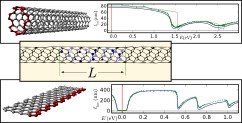We study transport length scales in carbon nanotubes and graphene ribbons under the influence of Anderson disorder. We present generalized analytical expressions for the density of states, the elastic mean free path and the localization length in arbitrarily structured quantum wires. These allow us to analyze the electrical response over the full energy range, including the regions around van Hove singularies, traditionally difficult to access by alternative approaches. Comparing with the results of numerical simulations, we demonstrate that both the diffusive and the localized regime are well represented by the analytical approximations over a wide range of the energy spectrum. The approach works well for both metallic and semiconducting nanotubes and nanoribbons but breaks down near the edge states of zigzag ribbons.

We study transport length scales in carbon nanotubes and graphene ribbons under the influence of Anderson disorder. We present generalized analytical expressions for the density of states, the elastic mean free path and the localization length in arbitrarily structured quantum wires. These allow us to analyze the electrical response over the full energy range, including the regions around van Hove singularies, traditionally difficult to access by alternative approaches. Comparing with the results of numerical simulations, we demonstrate that both the diffusive and the localized regime are well represented by the analytical approximations over a wide range of the energy spectrum. The approach works well for both metallic and semiconducting nanotubes and nanoribbons but breaks down near the edge states of zigzag ribbons.
